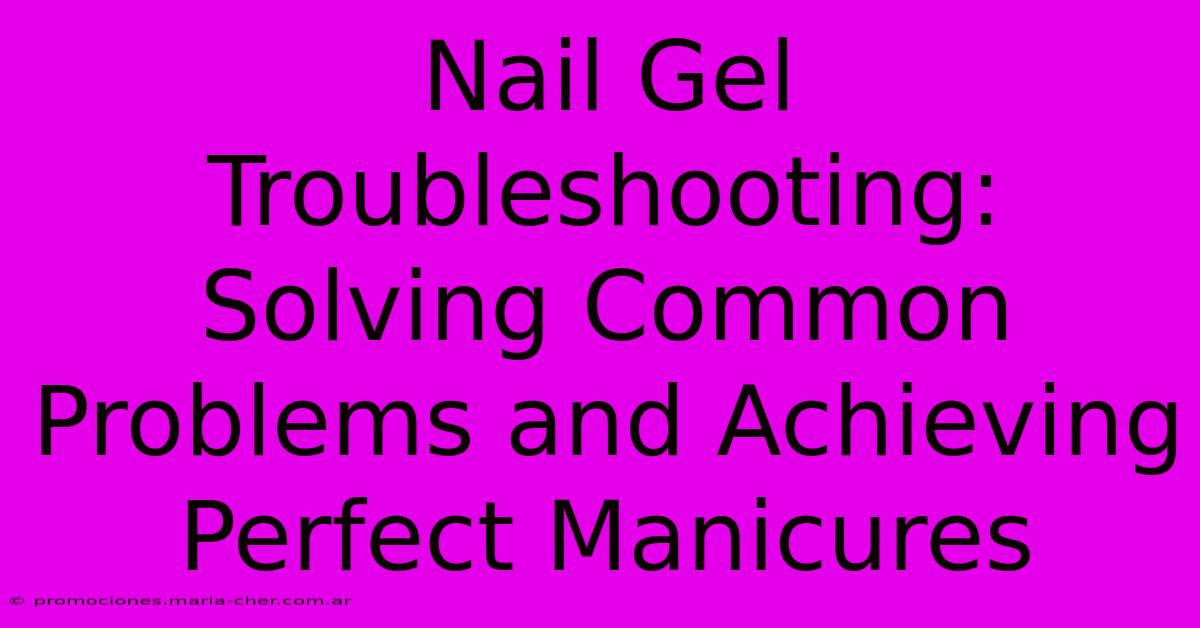Nail Gel Troubleshooting: Solving Common Problems And Achieving Perfect Manicures

Table of Contents
Nail Gel Troubleshooting: Solving Common Problems and Achieving Perfect Manicures
Achieving the perfect gel manicure can feel like a quest for the holy grail. Shiny, long-lasting nails are the goal, but often, we encounter frustrating problems along the way. This comprehensive guide will troubleshoot common gel manicure issues, helping you achieve salon-worthy results from the comfort of your own home. We'll cover everything from application techniques to fixing common mistakes, ensuring your next gel manicure is flawless.
Common Gel Manicure Problems and Their Solutions
Gel manicures offer a longer-lasting shine and durability compared to traditional polish. However, several issues can arise during the process, leading to less-than-perfect results. Let's address some of the most frequent problems:
1. Lifting and Chipping:
This is arguably the most common complaint. Lifting, where the gel separates from the nail, and chipping, where pieces of the gel break off, ruin the manicure's longevity and appearance.
- Causes: Insufficient preparation (poor cleaning, oily nails), incorrect application technique (too thick layers, inadequate curing), or using low-quality products.
- Solutions: Thoroughly clean and dehydrate nails before applying the base coat. Apply thin, even coats of gel, ensuring proper curing time in the lamp. Invest in reputable gel brands known for their adhesion. Avoid using excessively strong detergents or harsh chemicals on your nails. Consider using a nail dehydrator and primer for optimal adhesion.
2. Smudges and Unevenness:
A bumpy or uneven finish detracts from the overall look. Smudges are particularly frustrating, often occurring during the curing process.
- Causes: Applying too much gel, not allowing adequate drying time between coats, touching the wet gel, or using a lamp that isn't powerful enough.
- Solutions: Use thin coats, cure thoroughly after each layer, avoid touching the wet gel, and ensure your lamp is functioning correctly. Invest in a high-quality lamp with a timer to ensure complete curing. Gentle filing and buffing after the final cure can help smooth out minor imperfections.
3. Streaks and Bubbles:
Streaks and bubbles can appear unsightly in your finished manicure, impacting its professional appearance.
- Causes: Using old or improperly stored gel polish, shaking the bottle (introduces air bubbles), applying gel too quickly, or using a contaminated brush.
- Solutions: Check the expiry date on your gel polish and ensure proper storage. Gently roll the bottle to mix the polish instead of shaking. Apply the gel slowly and deliberately in thin layers. Clean your brush regularly to prevent contamination.
4. Gel Polish Too Thick/Thin:
Both too thick and too thin applications cause problems. Thick applications don't cure properly, while thin applications are prone to chipping.
- Causes: Inaccurate dispensing, improper application technique, or using a brush that is too thick or thin for your application.
- Solutions: Practice applying thin coats with even strokes. Use the correct amount of polish for your nail size and shape. Invest in high-quality brushes that distribute the polish evenly.
5. Difficulty Removing Gel Polish:
Removing gel polish without damaging the natural nail requires the correct technique.
- Causes: Using incorrect removal products or techniques.
- Solutions: Soak cotton pads in pure acetone, wrap them around your nails, and cover with foil. Let it soak for 10-15 minutes before gently pushing off the softened gel. Never aggressively peel or scrape off gel polish.
Tips for Achieving Perfect Gel Manicures
Beyond troubleshooting, here are some essential tips for achieving consistently flawless gel manicures:
- Proper Nail Prep: This is crucial! Clean, dry, and oil-free nails are essential for adhesion.
- Quality Products: Invest in high-quality gel polish, base coat, top coat, and a reliable UV/LED lamp.
- Thin Coats: Always apply thin coats to ensure proper curing and prevent lifting.
- Curing Time: Follow the manufacturer's recommended curing time meticulously.
- Proper Aftercare: Avoid harsh chemicals and moisturize your cuticles regularly.
By understanding the common causes of gel manicure problems and following these troubleshooting tips, you can significantly improve your chances of achieving perfect, long-lasting results. Remember, practice makes perfect! With patience and the right techniques, you'll be enjoying salon-worthy gel manicures at home in no time.

Thank you for visiting our website wich cover about Nail Gel Troubleshooting: Solving Common Problems And Achieving Perfect Manicures. We hope the information provided has been useful to you. Feel free to contact us if you have any questions or need further assistance. See you next time and dont miss to bookmark.
Featured Posts
-
Revolutionary Discovery The Lost Life Mask Of George Washington Found
Feb 09, 2025
-
Capture The Spirit T Is The Season For Dog Photo Christmas Cards
Feb 09, 2025
-
Outrageous Outfielders The Fastest Tracksters To Ever Patrol The Greens
Feb 09, 2025
-
Set The Scene For A Holy Celebration Announce Your Communion With Elegant Cards
Feb 09, 2025
-
Charred And Delectable Meat Free Veggies That Mimic The Flavor
Feb 09, 2025
